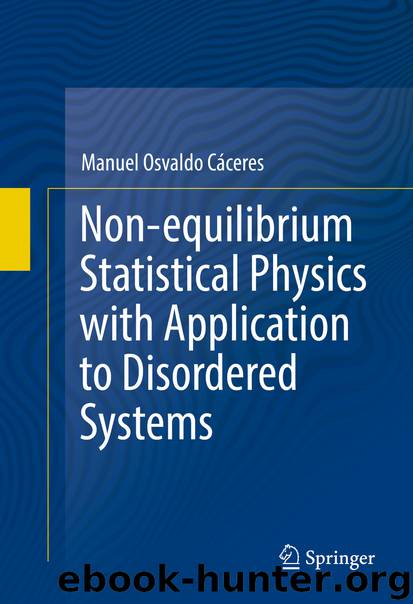Non-equilibrium Statistical Physics with Application to Disordered Systems by Manuel Osvaldo Cáceres

Author:Manuel Osvaldo Cáceres
Language: eng
Format: epub
Publisher: Springer International Publishing, Cham
(6.33)
Excursus. Note that the properties (6.31) and (6.32) are not sufficient to ensure that there exists a matrix U such that U −1 ⋅ H ⋅ U is diagonal [something similar happens with the Markov matrix T 1, see Sect. 6.1.1]. Only the principle of detailed balance21 allows to symmetrize H under a certain scalar product.22 This means that in general we can only ensure a similarity transformation to the Jordan form . We propose exercises to clarify this further.
Exercise. Interpret the differences between the Markov matrix T 1 (Markov chains with discrete time) and the matrix H (for continuous-time Markov processes ); in particular the normalizations: and respectively. Hint: assuming a characteristic time scale write and expand the exponential operator.
Excursus. If the matrix H is not reducible (see Appendix B), properties (6.31) and (6.32) are sufficient to ensure that there is a single stationary state , and thus the relaxation to it from any initial condition . That is: .
Download
This site does not store any files on its server. We only index and link to content provided by other sites. Please contact the content providers to delete copyright contents if any and email us, we'll remove relevant links or contents immediately.
The Complete Stick Figure Physics Tutorials by Allen Sarah(7135)
Secrets of Antigravity Propulsion: Tesla, UFOs, and Classified Aerospace Technology by Ph.D. Paul A. Laviolette(4974)
Thing Explainer by Randall Munroe(3782)
The River of Consciousness by Oliver Sacks(3412)
The Order of Time by Carlo Rovelli(3071)
How To by Randall Munroe(2911)
I Live in the Future & Here's How It Works by Nick Bilton(2839)
A Brief History of Time by Stephen Hawking(2819)
What If?: Serious Scientific Answers to Absurd Hypothetical Questions by Randall Munroe(2542)
The Great Unknown by Marcus du Sautoy(2532)
Midnight in Chernobyl by Adam Higginbotham(2384)
Blockchain: Ultimate Step By Step Guide To Understanding Blockchain Technology, Bitcoin Creation, and the future of Money (Novice to Expert) by Keizer Söze(2379)
Networks: An Introduction by Newman Mark(2264)
The Meaning of it All by Richard Feynman(2213)
Easy Electronics by Charles Platt(2204)
The Tao of Physics by Fritjof Capra(2162)
Midnight in Chernobyl: The Untold Story of the World's Greatest Nuclear Disaster by Adam Higginbotham(2074)
When by Daniel H Pink(2019)
Introducing Relativity by Bruce Bassett(2015)
